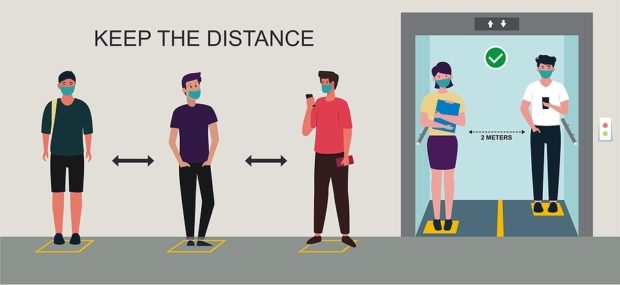Now that COVID-19 vaccines are within reach, city officials, business administrators, and high-rise building managers are planning how to safely and efficiently open offices as people come back to work. But with social distancing and masking likely still needed, the capacity of both elevators and building lobbies will continue to be limited and it could take workers a very long time to get to their desks.
Elevators are the key component of the “vertical transportation industry” that so many people use to get to their offices each day, but social distancing has reduced elevator capacity by at least half and as much as two-thirds the amount during “normal” times. When buildings fully reopen with the usual amount of foot traffic, the length of queues will likely explode during rush hour, thus posing a significant public health risk.
Over the past few months, Columbia Engineering researchers have been working on ways to explore solutions to this problem, informed by real-world data and context provided by the Office of the Mayor of New York City. They used mathematical modeling and epidemiological principles to design interventions for queuing safely in elevators during a pandemic, without having to program any elevators.
“Our interventions basically reduce congestion by explicitly or implicitly trying to get people going to the same floor to travel together,” says Adam N. Elmachtoub, associate professor of industrial engineering and operations research (IEOR) and a member of Columbia’s Data Science Institute (DSI). The team worked with Charles C. Branas, Gelman Professor and chair of epidemiology at the Mailman School of Public Health, to translate their algorithms into safe and practical interventions.
The goal of the team, which includes IEOR and Computer Science Professor Clifford Stein and IEOR PhD students Sai Mali Ananthanarayanan and Yeqing Zhou, was to manage elevator lines by drastically reducing the waiting time and length of lobby queues. In simulations based on an actual 25-story building, the researchers compared the traditional “first-come, first-served” method of loading elevators with two different interventions they call Cohorting and Queue Splitting.
With the traditional approach during the pandemic, the queue length in the lobby keeps growing and growing. Using the Cohorting intervention, the team grouped passengers together who were going to the same floor as the first person in the queue. Under the Queue Splitting approach, the researchers created different lines for people going to different groups of floors.
Based on their simulations, the researchers found that both the Cohorting and Queue Splitting interventions not only significantly reduced queue length and wait time, but also enables workers to keep safe distances from viral transmissions in what would otherwise be overcrowded elevators, building lobbies, and entrances. These proposed interventions are simple and easy to implement, relying on signage or a queue manager to guide passengers. They could work especially well in cities like NYC, where many elevator systems are older and changing their algorithms and technology would require long-term planning and expensive modifications.
“This project shows the critical role of interdisciplinary collaboration, both intellectually between data science and other areas like public health, but also between city government and academic institutions in working on applied problems grounded in real-world constraints,” said Neal Parikh, Director of Artificial Intelligence for the City of New York. “This is a key way to facilitate the responsible and beneficial use of algorithms and other mathematical and computational tools in society.”
Each building may choose a different intervention, depending on its particular simulation results, physical layout, personnel, and epidemiological principles. The researchers are refining their simulation model and testing out the policies on many different building designs.
“The interventions we study apply to generic buildings, and we have provided open-source code that can be customized and studied for other building types,” says Ananthanarayanan, co-lead author of the paper, a preprint of which is posted on Social Science Research Network (SSRN).
Adds Zhou, also a co-lead author, “Our simulation model is not only general, in that it can be adapted to any number of elevators, floors, and general traffic patterns, but it also takes into account potential issues in implementation such as the impact of limited lobby space. It’s very flexible.”
While these initial approaches offer simple, low-tech solutions, the team is also looking at more advanced elevator systems that would enable them to embed AI technologies to more efficiently and safely manage elevators. They are developing algorithms for moving elevators that can depend on the global state of the system, which can be measured via sensors in the elevators and waiting areas.
“We’ve simulated for different building types and calibrated data from a large New York City building,” says Stein, who is also the Associate Director of Research at the Data Science Institute. “Our proposed interventions will be useful to any high-rise building managers who are formulating reopening plans. We’re excited to be part of engineering a speedy recovery for New York City and locations around the world with a vertical transportation solution.”
About the Study
The study is titled “Queuing Safely for Elevator Systems Amidst a Pandemic.”
Authors are: Sai Mali Ananthanarayanan, Adam Elmachtoub, Clifford Stein, and Yeqing Zhou (all Department of Industrial Engineering and Operations Research, Columbia Engineering), and Charles C. Branas (Mailman School of Public Health).
The study was supported by an $85,000 award under Columbia Engineering’s “Urban Living Tech Innovations” initiative to develop technology innovations for urban living in the face of COVID-19. Adam Elmachtoub and Yeqing Zhou were also supported by National Science Foundation CMMI-1944428. Cliff Stein and Sai Mali Ananthanarayanan were also supported by National Science Foundation CCF-1714818.
The authors declare no financial or other conflicts of interest.
Source: Columbia University School of Engineering and Applied Science





















 Reporter’s Notebook: ‘Nobody Else Does Telematics,’ Lemonade Exec Says
Reporter’s Notebook: ‘Nobody Else Does Telematics,’ Lemonade Exec Says  Insured Losses From Los Angeles Wildfires Rising: $8B to $20B
Insured Losses From Los Angeles Wildfires Rising: $8B to $20B  California Insurers Required to Increase Home Coverage in High Risk Wildfire Areas
California Insurers Required to Increase Home Coverage in High Risk Wildfire Areas  Surviving the ‘Silver Tsunami’: Closing the Talent, Skills Gap in Underwriting
Surviving the ‘Silver Tsunami’: Closing the Talent, Skills Gap in Underwriting 




